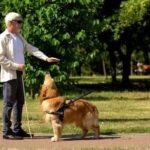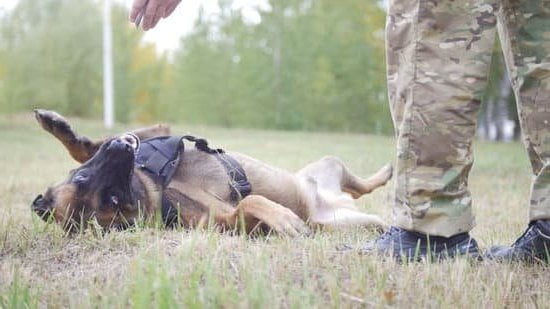Training a dog to sense anxiety attacks can be a life-changing skill for both the dog and their owner. Dogs have an incredible ability to pick up on subtle changes in our behavior and emotions, making them perfect companions for individuals struggling with anxiety disorders.
In this article, we will explore the importance of training a dog to detect anxiety attacks, including the signs and symptoms to look out for, the science behind a dog’s sensing abilities, and the benefits of having a canine companion that can provide support during difficult times.
Anxiety attacks can manifest in various ways, from rapid heart rate and sweating to feelings of dread and panic. For those experiencing these overwhelming symptoms, having a dog trained to sense impending anxiety attacks can offer a sense of security and comfort.
Dogs have an innate ability to detect changes in their owner’s mood and behavior, allowing them to provide support before an anxiety attack reaches its peak intensity. By understanding what triggers these episodes and how a dog can help alleviate symptoms, individuals can take proactive steps to improve their mental well-being.
The bond between a human and their furry companion goes beyond just companionship; it is built on trust, understanding, and unconditional love. When trained properly, dogs can anticipate anxiety attacks before they occur, helping their owners manage their condition more effectively.
In the following sections of this article, we will delve into the step-by-step guide on how to train a dog to sense anxiety attacks, the tools and techniques necessary for successful training, common mistakes to avoid along the way, and real-life success stories showcasing the incredible impact trained dogs have had on individuals struggling with anxiety disorders.
What Are Anxiety Attacks
Anxiety attacks, also known as panic attacks, are intense periods of overwhelming fear or distress that can be debilitating for those experiencing them. Understanding the signs and symptoms of anxiety attacks is crucial not only for those who suffer from them but also for individuals looking to train their dogs to sense and respond to these situations effectively.
During an anxiety attack, individuals may experience a rapid heart rate, sweating, trembling, shortness of breath, chest pain, nausea, dizziness, and feelings of impending doom. These physical and emotional symptoms can vary in intensity and duration but are typically sudden and overwhelming. Recognizing these signs is the first step in training a dog to detect when their owner is experiencing an anxiety attack.
Dogs have an incredible ability to pick up on subtle changes in their human companions’ behavior and body language. Research suggests that dogs can detect changes in cortisol levels, heart rate, breathing patterns, and even specific scents that are released during times of stress or anxiety. By understanding these physiological cues, dog owners can effectively train their furry friends to alert them when they are exhibiting signs of an anxiety attack.
| Anxiety Attack Symptoms | Physical Indicators |
|---|---|
| Rapid heart rate | Sweating |
| Trembling | Shortness of breath |
| Chest pain | Feelings of impending doom |
The Science Behind a Dog’s Ability to Sense Anxiety Attacks
Dogs have an incredible ability to pick up on their owner’s emotions and physical cues, making them excellent candidates for detecting anxiety attacks. The science behind a dog’s capability to sense anxiety attacks lies in their keen sense of smell and observational skills. Dogs have around 300 million olfactory receptors in their noses, compared to about 6 million in humans, allowing them to detect even the subtlest changes in body chemistry that occur during an anxiety attack.
Here are some reasons why dogs can sense anxiety attacks so effectively:
1. Olfactory Receptors: Dogs have a highly developed sense of smell that allows them to detect changes in hormones, such as cortisol and adrenaline levels, which fluctuate during times of stress or anxiety.
2. Body Language: Dogs are experts at reading body language and facial expressions. They can pick up on slight movements or changes in posture that may indicate an impending anxiety attack.
3. Empathy: Dogs have been known to form strong bonds with their owners and can often sense when something is not right. This ability to empathize with their human companions enables them to anticipate when an anxiety attack is about to occur.
Overall, the combination of these factors contributes to a dog’s natural instinct to provide comfort and support during times of distress. By understanding the science behind a dog’s ability to sense anxiety attacks, pet owners can better appreciate the value of training their furry companions to assist in managing their mental health effectively”.
The Benefits of Having a Dog That Can Detect Anxiety Attacks
Having a dog that can detect anxiety attacks can be life-changing for individuals who suffer from anxiety disorders. The emotional support and sense of security provided by a trained dog that can sense anxiety attacks are invaluable. Here are some key benefits of having a dog that can detect anxiety attacks:
- Early Detection: Dogs have an incredible sense of smell and can detect changes in their owner’s body chemistry before an anxiety attack occurs. This early detection allows the individual to take necessary precautions or seek help before the attack escalates.
- Emotional Support: Knowing that a loyal and attentive companion is by their side, ready to provide comfort during times of distress, can greatly reduce feelings of isolation and fear for individuals with anxiety disorders.
- Improved Quality of Life: With a trained dog that can sense anxiety attacks, individuals may feel more confident in managing their condition. This increased sense of control over their symptoms can lead to a higher quality of life overall.
Training a dog to detect anxiety attacks is not only beneficial for the individual with an anxiety disorder but also strengthens the bond between the dog and its owner. Through proper training and reinforcement, dogs can learn to pick up on subtle cues indicating an impending anxiety attack.
- Positive Reinforcement: Use treats and praise to reward your dog when they correctly identify signs of an upcoming anxiety attack. This positive reinforcement will encourage them to continue this behavior.
- Consistent Training: Consistency is key when training a dog to sense anxiety attacks. Regular practice sessions will help reinforce the behaviors you want your dog to exhibit in response to detecting signs of distress.
- Patience and Persistence: Training a dog takes time, so it’s important to be patient and persistent throughout the process. Celebrate small successes and remain dedicated to helping your furry companion become proficient at sensing anxiety attacks.
By investing time and effort into training your dog to detect anxiety attacks, you are not only providing yourself with additional support but also enriching your canine companion’s life by giving them a meaningful job to do.
Step-by-Step Guide on How to Train a Dog to Sense Anxiety Attacks
Dogs are known for their ability to detect changes in human behavior and emotions, making them excellent companions for individuals struggling with anxiety attacks. Training a dog to sense anxiety attacks can be a life-changing endeavor for both the dog and their owner. By teaching your furry friend to recognize the signs of an impending anxiety attack, you can potentially prevent or lessen the severity of such episodes.
One of the first steps in training a dog to sense anxiety attacks is to establish a strong bond and understanding between the dog and their owner. This relationship is crucial as it forms the basis for effective communication and trust.
Dogs are highly intuitive animals, capable of picking up on subtle cues and changes in body language. By observing your behavior during an anxiety attack, your dog can learn to associate certain signs or actions with this state of distress.
Once a solid bond has been established, specific training techniques can be implemented to teach your dog how to recognize when you are experiencing an anxiety attack. One common approach is using positive reinforcement, where the dog is rewarded (treats, praise) for correctly identifying signs of an oncoming anxiety episode.
Consistent practice and repetition are key components of this training process, as they help reinforce the learned behaviors over time. In addition, exposing your dog to different situations and environments where anxiety attacks may occur can further hone their detection abilities.
| Training Techniques | Benefits |
|---|---|
| Positive Reinforcement | Strengthens bond between dog and owner |
| Consistent Practice | Reinforces learned behaviors over time |
| Exposure to Different Environments | Hones detection abilities in various settings |
Tools and Techniques for Training a Dog to Detect Anxiety Attacks
Tools for Training a Dog to Detect Anxiety Attacks
When embarking on the journey of training your dog to sense anxiety attacks, it is important to have the right tools at your disposal. One of the most essential tools is patience. Training a dog to detect anxiety attacks takes time and consistency, so being patient throughout the process is key.
Additionally, having treats that your dog loves can be a great motivator during training sessions. Using a clicker can also help reinforce positive behavior as your dog learns to associate the sound with their successful detection.
Techniques for Training a Dog to Sense Anxiety Attacks
One effective technique for training a dog to sense anxiety attacks is desensitization. This involves exposing your dog to controlled situations that simulate anxiety or stress, gradually increasing the intensity over time.
By rewarding your dog for accurately detecting these simulated anxiety attacks, they can learn to recognize the signs and respond accordingly in real-life situations. Another technique is using scent cues, where you can introduce scents associated with anxiety attacks during training sessions and reward your dog for reacting positively to them.
Consistency and Positive Reinforcement
Consistency in training is crucial when teaching your dog to detect anxiety attacks. Establishing a routine and practicing regularly will help reinforce their learning. It is also important to use positive reinforcement such as treats, praise, or playtime whenever your dog successfully detects an anxiety attack or shows progress in their training.
Positive reinforcement not only motivates your dog but also strengthens the bond between you and helps them associate their actions with positive outcomes. Remember, every dog learns at their own pace, so be patient and celebrate small victories along the way.
Common Mistakes to Avoid When Training a Dog to Sense Anxiety Attacks
When training a dog to sense anxiety attacks, it is important to avoid common mistakes that can hinder the process and potentially even harm the dog’s well-being. One common mistake is rushing the training process. It is crucial to remember that training a dog to detect anxiety attacks requires time, patience, and consistency. Trying to rush through the steps or expecting instant results can be counterproductive.
Lack of Positive Reinforcement
Another mistake to avoid is neglecting positive reinforcement during training. Dogs respond well to praise, treats, and rewards when they exhibit the desired behavior. By not providing positive reinforcement when the dog successfully detects an anxiety attack symptom, you may confuse or demotivate them. Consistent positive feedback is essential for reinforcing the behavior you want your dog to exhibit.
Skipping Basic Training
Skipping basic obedience training before diving into specific tasks like detecting anxiety attacks can also be a mistake. A strong foundation in obedience commands such as sit, stay, and come is essential for effective communication between you and your dog during training sessions. Without these basics, your dog may struggle to understand what is expected of them in more complex tasks like sensing anxiety attacks.
Real-Life Success Stories
Dogs have been proven to be incredibly intuitive creatures, able to pick up on subtle changes in their owner’s behavior and emotions. This unique ability has made them invaluable companions for individuals suffering from anxiety disorders. Trained dogs have shown remarkable success in providing support and assistance during anxiety attacks, making a significant difference in the lives of those dealing with such conditions.
One real-life success story involves a woman named Sarah who struggled with severe panic attacks due to her generalized anxiety disorder. After undergoing training with a certified professional, her dog, Max, was able to sense when Sarah’s heart rate increased and her breathing became shallow – both signs of an impending anxiety attack.
Max would then nudge Sarah’s hand or lay his head on her lap, providing comfort and grounding her in the present moment. Thanks to Max’s training and attentiveness, Sarah has been able to manage her anxiety more effectively and regain a sense of control over her life.
Another inspiring example is Mark, a veteran suffering from PTSD (Post-Traumatic Stress Disorder) as a result of his time in combat. His trained service dog, Luna, has been instrumental in detecting the early signs of an impending panic attack or flashback. Luna is trained to paw at Mark’s leg or bark softly as soon as she senses heightened levels of stress or anxiety in him.
This allows Mark to take proactive steps to calm himself down before the full-blown panic attack sets in. The presence of Luna by his side has not only provided Mark with a sense of security but has also enabled him to venture out into public spaces without constant fear and worry.
Conclusion
In conclusion, training a dog to sense anxiety attacks can truly be a life-changing investment for individuals struggling with anxiety disorders. The ability of dogs to detect changes in their owner’s behavior and physiology has been proven time and time again, offering a sense of security and support when experiencing an anxiety attack.
By understanding the signs and symptoms of anxiety attacks and the science behind a dog’s ability to sense them, individuals can work towards forming a close bond with their furry companions that goes beyond simple companionship.
It is essential for dog owners to follow a step-by-step guide on how to train their dogs to sense anxiety attacks, utilizing tools and techniques specifically designed for this purpose. Consistency, positive reinforcement, and patience are key elements in successfully training a dog to detect anxiety attacks. Avoiding common mistakes such as inconsistent training methods or expecting immediate results is crucial in ensuring the effectiveness of the training process.
Real-life success stories serve as powerful testimonials to the invaluable support that trained dogs can provide individuals with anxiety disorders. From alerting their owners before an impending anxiety attack to providing comfort during moments of distress, these dogs have proven themselves to be loyal companions and life-saving allies. Therefore, I encourage readers to consider investing in training their own dogs to detect anxiety attacks, as it can make a significant difference in managing and coping with anxiety disorders.
Frequently Asked Questions
How Do I Train My Dog to Recognize a Panic Attack?
Training your dog to recognize a panic attack involves teaching them to recognize your specific symptoms through consistent exposure. For example, you can use the scent of lavender or a specific command to signal when you are experiencing an attack.
What Is the 3 3 3 Rule for Anxiety?
The 3 3 3 rule for anxiety is a technique that involves naming three things you see, hear, and feel during an anxious moment. This grounding exercise helps bring your focus back to the present moment and can reduce feelings of anxiety by shifting your attention away from intrusive thoughts.
Can Dogs Sense Anxiety Attacks?
Dogs have the ability to sense changes in their owner’s behavior and emotions, including anxiety attacks. Some dogs are trained as psychiatric service animals specifically to detect and respond to their owner’s anxiety by providing comfort and support. They may exhibit behaviors such as licking, pawing, or leaning on their owner during an anxiety attack.

Welcome to the blog! I am a professional dog trainer and have been working with dogs for many years. In this blog, I will be discussing various topics related to dog training, including tips, tricks, and advice. I hope you find this information helpful and informative. Thanks for reading!





